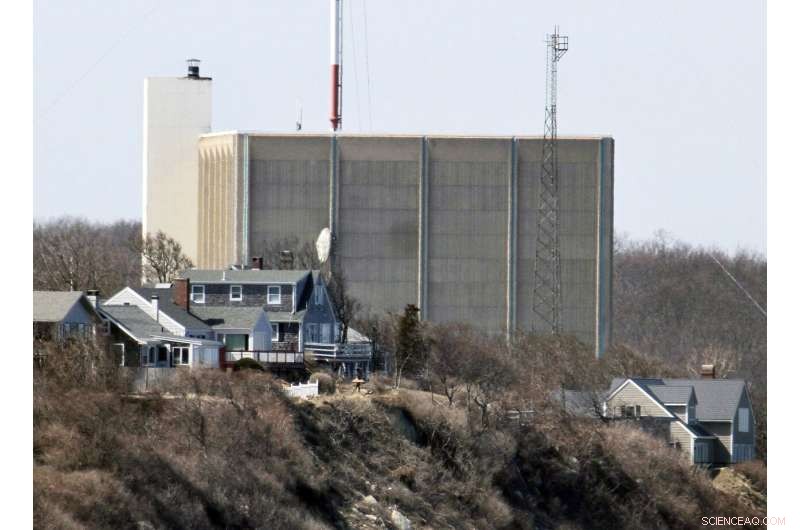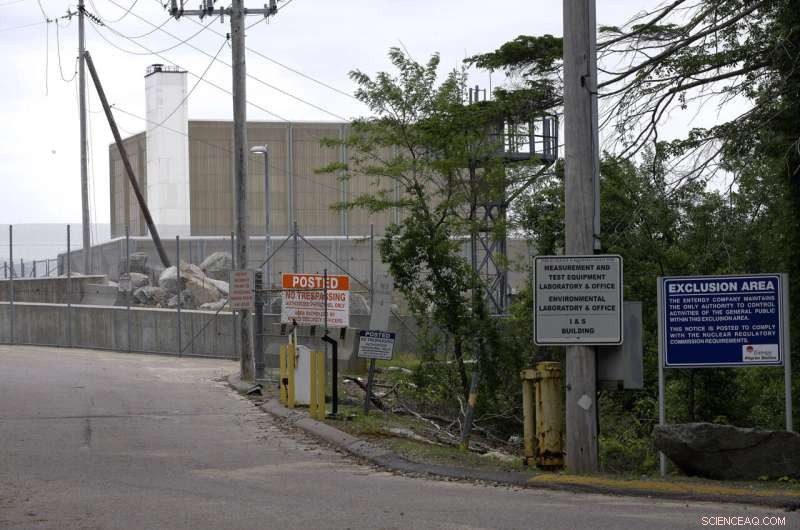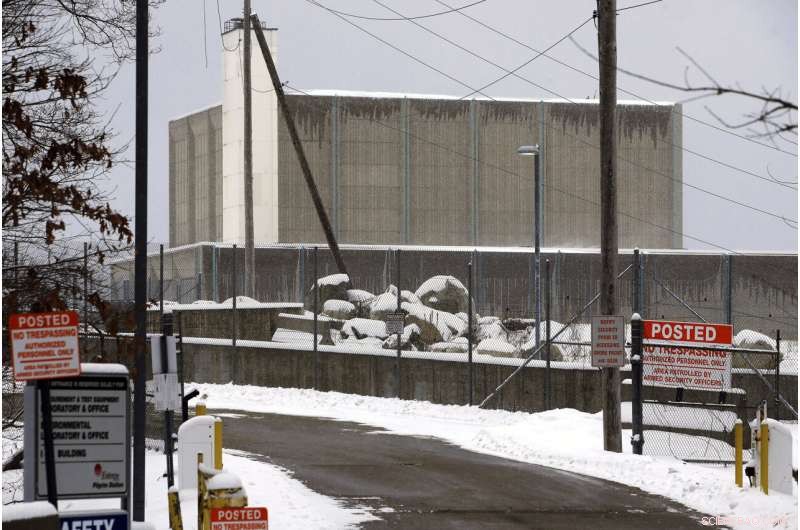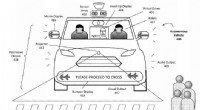
Wetenschap
UITLEG:Wat te doen met afvalwater van gesloten kerncentrales?

Een deel van de Pilgrim Nuclear Power Station is zichtbaar achter huizen langs de kust van Cape Cod Bay, in Plymouth, Massachusetts, 30 maart 2011. Pilgrim, die in 2019 werd gesloten, was een kokendwaterreactor. Water circuleerde constant door het reactorvat en de nucleaire brandstof en zette het om in stoom om de turbine te laten draaien. Het water werd gekoeld en gerecirculeerd, waarbij radioactieve besmetting werd opgepikt. Credit:AP Foto/Steven Senne, Bestand
Een miljoen liter radioactief water bevindt zich in een voormalige kerncentrale langs Cape Cod Bay en het moet weg.
Maar waar is de lastige vraag en zal de staat ingrijpen als het bedrijf dat de fabriek ontmantelt beslist?
Holtec International overweegt het water te zuiveren en in de baai te lozen, wat hevig verzet oproept bij omwonenden, schelpenvissers en politici. Holtec overweegt ook om het verontreinigde water te verdampen of naar een faciliteit in een andere staat te transporteren.
De strijd in Massachusetts weerspiegelt een actueel, verhit debat in Japan over een plan om in het voorjaar van 2023 meer dan 1 miljoen ton behandeld radioactief afvalwater uit de verwoeste kerncentrale van Fukushima in de oceaan te lozen. Een enorme tsunami in 2011 stortte neer op de fabriek. Drie reactoren zijn omgesmolten.
Pilgrim Nuclear Power Station in Plymouth, Massachusetts, sloot in 2019 na bijna een halve eeuw elektriciteit te hebben geleverd aan de regio. De Amerikaanse vertegenwoordiger William Keating, een democraat wiens district de Kaap omvat, schreef Holtec in januari samen met andere topwetgevers in Massachusetts om zich te verzetten tegen het vrijgeven van water in Cape Cod Bay. Hij vroeg de U.S. Nuclear Regulatory Commission om haar regelgeving te onderzoeken.
Keating zei eind maart dat Holtec's omgang met het radioactieve water een precedent zou kunnen scheppen, omdat de Amerikaanse ontmantelingsindustrie nog in de kinderschoenen staat. De meeste Amerikaanse kerncentrales werden gebouwd tussen 1970 en 1990.
"Als ze luisteren, gevoelig zijn en samenwerken met deze gemeenschappen, is het belangrijk," zei hij. "Dat is de boodschap voor toekomstige ontmantelingssites."
Holtec heeft in het hele land gesloten kerncentrales verworven als onderdeel van zijn ontmantelingsactiviteiten, waaronder het voormalige Oyster Creek Generating Station in New Jersey en het Indian Point Energy Center in New York. Het wordt eigenaar van de kerncentrale Palisades aan Lake Michigan, die dit jaar wordt gesloten.
Pilgrim was een kokendwaterreactor. Water circuleerde constant door het reactorvat en de nucleaire brandstof en zette het om in stoom om de turbine te laten draaien. Het water werd gekoeld en gerecirculeerd, waarbij radioactieve besmetting werd opgepikt.
Cape Cod is een toeristische trekpleister. Het hebben van radioactief water in de baai, zelfs lage niveaus, is niet geweldig voor marketing, zei de Democratische staatsvertegenwoordiger Josh Cutler, die daar een district vertegenwoordigt. Cutler werkt aan wetgeving om het lozen van radioactief materiaal in kust- of binnenwateren te verbieden.
Holtec zei dat Pilgrim al 50 jaar water in de baai loosde terwijl de fabriek in bedrijf was en dat milieustudies, uitgevoerd door de fabrieksexploitanten en nu Holtec, weinig of geen milieu-impact hebben aangetoond. Radiologische milieurapporten worden jaarlijks gedeeld met het NRC.
"We werken eraan wetenschappelijke gegevens te verstrekken, het publiek voor te lichten over de realiteit van straling in het dagelijks leven, en werken eraan om experts de ware wetenschap te laten verklaren versus de emotionele angst voor het onbekende", schreef woordvoerder Patrick O'Brien in maart in een e-mail. .

Warning signs are posted near a gate to the Pilgrim Nuclear Power Station, in Plymouth, Mass., Tuesday, May 28, 2019. Pilgrim, which closed in 2019, was a boiling water reactor. Water constantly circulated through the reactor vessel and nuclear fuel, converting it to steam to spin the turbine. The water was cooled and recirculated, picking up radioactive contamination. Credit:AP Photo/Steven Senne, File
WHAT ARE HOLTEC'S OPTIONS?
Holtec could treat the water and discharge it in batches over multiple years, likely the least expensive option. Or, it could evaporate the water on site, as it says it has done with about 680,000 gallons (2,600 kiloliters) over the past two years.
Evaporating the water would be more challenging to do now because the spent nuclear fuel is in storage, and couldn't be used as a heat source. Holtec would have to use a different—likely more expensive—method that would release gas.
Or, Holtec could truck the water to an out-of-state facility, where it could be mixed with clay and buried or placed in an evaporation pond, or released into local waterways. That's what Keating wants.
Vermont Yankee Nuclear Power Station, another boiling water reactor, was shut down in Vernon, Vermont, in 2014. It's sending wastewater to disposal specialists in Texas and other states. Entergy operated and sold both Vermont Yankee and Pilgrim. NorthStar, a separate and competing corporation in the decommissioning business, is dismantling Vermont Yankee.
Nuclear plants occasionally need to dispose of water with low levels of radioactivity when they're operating, so a process to release it in batches into local waterways was developed early in the nuclear industry.
In recent years at Pilgrim, the two largest releases were in 2011, with 29 releases totaling about 325,000 gallons (1,500 kiloliters), and 2013, with 21 releases totaling about 310,000 gallons.
The water from those releases was well below the federal limits for the amount of radionuclides in millirems a person would be exposed to in a year if they ate local seafood or swam in nearby waters, according to the NRC.
NRC spokesperson for the Northeast Neil Sheehan said the limits are set very conservatively and are believed to be protective of the public and environment. He said it's important to consider the role of dilution—once the discharges mix with vast quantities of water any radioactivity is typically not detectable.
WHY ARE PEOPLE WORRIED?
In Duxbury, Kingston and Plymouth Bays, there are 50 oyster farms—the largest concentration in the state, worth $5.1 million last year, according to the Massachusetts Seafood Collaborative. The collaborative said dumping the water would devastate the industry, and the local economy along with it.
Diane Turco, a Harwich resident and longtime Pilgrim watchdog, questions if the water is heavily contaminated, especially from the pool that covered the stored, spent fuel for cooling and shielded workers from radiation.

A no trespassing sign is posted near the entrance to the Pilgrim Nuclear Power Station, at rear, Thursday, Feb. 28, 2019, in Plymouth, Mass. One million gallons of radioactive water is contained inside the former nuclear power plant along Cape Cod Bay. The plant's owner, Holtec International, is considering treating the water and discharging it into the bay. Local residents, shell fishermen and politicians disapprove of the plan. Credit:AP Photo/Steven Senne, File
"Isn't this a crazy idea for Holtec to use our bay as their dump? No way," she said.
Others didn't know Pilgrim's water went into the bay in previous years and they don't want it to happen again.
"We can't change that, but we can change what's happening in the future," said Cutler, the state lawmaker. "It's the first time it has ever been decommissioned, so to compare this to the past is a convenient excuse. 'Well, we did it in the past,' that sounds like my kid."
Towns on the Cape are trying to prohibit the dispersal of radioactive materials in their waters. Tribal leaders, fishermen, lobstermen and real estate agents have publicly stated their opposition as well.
Sheehan, the NRC spokesperson, said the water is not different or distinct, compared to water released during the plant's operations. Holtec would have to handle it the same way, by filtering it, putting it into a tank, analyzing the radio isotopes and calculating the environmental impacts if it was released in batches, he added.
WHO GETS THE FINAL SAY?
Holtec wouldn't need a separate approval from the NRC to discharge the water into the bay. However, Holtec would need permission from the U.S. Environmental Protection Agency if the water contained pollutants regulated by the Clean Water Act, such as dissolved metals.
If the water contained only radioactive materials regulated by the NRC, Holtec wouldn't need to ask the EPA for a permit modification, according to the EPA's water division for New England. Holtec has never given the EPA a pollutant characterization of the water associated with decommissioning, the division's director said.
Mary Lampert, of Duxbury, is on a panel created by the state to look at issues related to the Pilgrim's decommissioning. She believes the state could use its existing laws and regulations to stop the dumping and plans to press the Massachusetts attorney general to file a preliminary injunction to do so.
The attorney general's office said it's monitoring the issue and would take any Clean Water Act violations seriously.
Holtec said this week it's examining the water for possible pollutants but the lab results won't be available for awhile.
The company expects to decide what to do with the water later this year. Discharge, evaporation and some limited transportation will likely all be part of the solution, Holtec added.
 Atomaire afstemming op kobalt maakt een achtvoudige toename van de productie van waterstofperoxide mogelijk
Atomaire afstemming op kobalt maakt een achtvoudige toename van de productie van waterstofperoxide mogelijk Op klei gebaseerde antimicrobiële verpakking houdt voedsel vers
Op klei gebaseerde antimicrobiële verpakking houdt voedsel vers Nieuwe robotsensortechnologie kan reproductieve gezondheidsproblemen in realtime diagnosticeren
Nieuwe robotsensortechnologie kan reproductieve gezondheidsproblemen in realtime diagnosticeren Het geheim van katalysatoren die de efficiëntie van brandstofcellen verhogen
Het geheim van katalysatoren die de efficiëntie van brandstofcellen verhogen Inzicht in coronavirusvarianten
Inzicht in coronavirusvarianten
 5 kenmerken die alle vissen gemeen hebben
5 kenmerken die alle vissen gemeen hebben  Fox Creek-aardbevingen gekoppeld aan voltooiingsvolume en locatie van hydrofracturering
Fox Creek-aardbevingen gekoppeld aan voltooiingsvolume en locatie van hydrofracturering Onderzoeker bestudeert effecten microplastics op oceaan
Onderzoeker bestudeert effecten microplastics op oceaan Nematoden begrijpen om klimaatverandering aan te pakken
Nematoden begrijpen om klimaatverandering aan te pakken Rusland lanceert gigantisch Yamal-gasproject in het noordpoolgebied
Rusland lanceert gigantisch Yamal-gasproject in het noordpoolgebied
Hoofdlijnen
- Een elektrolytendrank met kipsmaak kan snuffelhonden helpen gehydrateerd te blijven
- Wat is de functie van het enzym ligase bij het vormen van recombinant DNA?
- Nieuwe hoop voor ernstig bedreigde aap met stompe neus in Myanmar
- Onderzoek identificeert geslachts-aangepast kleurveranderingsgen in sprinkhanen
- Koralen kunnen tijdens hun leven verworven mutaties doorgeven aan nakomelingen
- Virusstamping - een veelzijdige nieuwe methode voor genetische manipulatie van afzonderlijke cellen
- Belangrijk eiwit voor virale infectie en erfelijke ziekte ontdekt
- Hoe zangvogels een nieuw lied leren
- Lege schelpen van weekdieren bevatten het verhaal van evolutie, zelfs voor uitgestorven soorten - nu kunnen we het decoderen
- Renault-alliantie niet in gevaar:Nissan-topman vertelt AFP

- Duitse vakbond dreigt met stakingen Lufthansa na kerst

- Boeing zegt dat het een Trump-deal heeft voor Air Force One-vliegtuigen

- AQM+:een nieuw model voor het genereren van visuele dialoogvragen

- Uber-octrooiaanvraag bespreekt intentiesignaleringssysteem

 Hoe werkt een kas?
Hoe werkt een kas?  Hoe recycle je water in een wasserette
Hoe recycle je water in een wasserette Inzichten in het vroege stadsleven
Inzichten in het vroege stadsleven Virtueel leren:AI gebruiken, onderdompeling om Chinees te leren
Virtueel leren:AI gebruiken, onderdompeling om Chinees te leren NASA vindt tropische storm Narda die zware regenval naar het westen van Mexico brengt
NASA vindt tropische storm Narda die zware regenval naar het westen van Mexico brengt Vrouwen TEDx-sprekers ontvangen meer gepolariseerde opmerkingen dan mannen:studie
Vrouwen TEDx-sprekers ontvangen meer gepolariseerde opmerkingen dan mannen:studie Een dag uit het leven van NASA's Voyagers
Een dag uit het leven van NASA's Voyagers Onderzoek laat zien hoe de productie bij windparken kan worden verbeterd
Onderzoek laat zien hoe de productie bij windparken kan worden verbeterd
- Elektronica
- Biologie
- Zonsverduistering
- Wiskunde
- French | Italian | Spanish | Portuguese | Swedish | German | Dutch | Danish | Norway |

-
Wetenschap © https://nl.scienceaq.com

